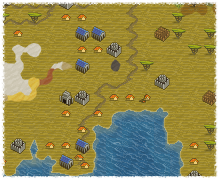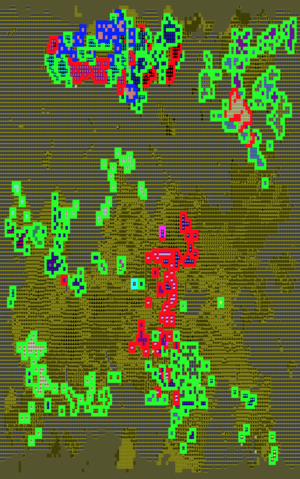- v50 information can now be added to pages in the main namespace. v0.47 information can still be found in the DF2014 namespace. See here for more details on the new versioning policy.
- Use this page to report any issues related to the migration.
Civilization
v53.08 · v0.47.05 This article is about the current version of DF.Note that some content may still need to be updated. |
A civilization (also known as an entity) is an organized society formed by a group of distinct, intelligent creatures. Civilizations are characterized by recognizable names and symbols, art forms, and languages, communities possessing common ethics and values, the development of advanced sites and structures, the use of defined resources, governing systems with individuals or groups exercising authority, interactions with the environment, and the creation of complex relationships and diplomacy between other entities, which can result in global networks of trade, the sharing of knowledge, and conflicts due to disagreements, which may break out into war.
World generation controls the number of civilizations in each world. All civilizations will initially be one of the five main races, although over time, individuals of other races can join them. In dwarf fortress mode, only dwarven civilizations are currently playable by default; to play as others requires modding. Adventurers can be from dwarven, elven, or human civilizations, or they can be human outsiders from no civilization.
To start an (unmodded) game in fortress mode, there must be one or more dwarven civilizations; by default, the Playable Civilization Required option ensures this is true. You can select your civilization at the site selection screen, and each will have some different items available for you to embark with.
Civilizations also determine what types of items a particular civilization can craft, that is why sometimes in a game, for example, your dwarven civilization might not know how to make a specific item, such as low boots.
Types of civilizations[edit]
Mountain[edit]
The mountain civilization is established by the dwarves ![]() /
/ ☺. Mountain civilizations centralize in industry, alcohol, mining deep, producing ☼masterful crafts☼, and creating pretty epic stories. Mountain civilizations build great fortresses on the edge of mountain ranges, smaller hillocks in the hill-lands, and mountain halls deep in the mountains. Fortresses and mountain halls are connected by roads and underground tunnels.
Plains[edit]
The plains civilization is established by the humans ![]() /
/ U. Humans are the most variable out of all the civilizations. Plains civilizations build vast towns and rural hamlets in low plains near bodies of water. Broad roads connect nearby towns together.
Forest[edit]
The forest civilization is established by the elves ![]() /
/ e. Forest civilizations are firmly devoted to the protection and well-being of nature, including trees. Especially trees. Harming plants (most importantly, trees) is considered an unspeakable crime. Forest civilizations build forest retreats made of large, outdoor structures of living trees in wooded areas.
Evil[edit]
The evil civilization is established by the goblins ![]() /
/ g. Evil civilizations are keen on going to war and rescuing kidnapping innocent children. They are undoubtedly the most cruel of all the civilizations. Evil civilizations construct sinister dark fortresses and blot the land with dark pits.
Evil civilizations are formed by certain supernatural beings from an eerie place.
Skulking[edit]
The skulking civilization is established by the kobolds ![]() /
/ k. Skulking civilizations steal items from nearby civilizations and stay distant from other affairs, populating the natural caves. Cave residents do not show as neighbors on the embark screen, and in default world-gen settings, the caves themselves are hidden from the map.
Subterranean animal people[edit]
Unnamed tribes spawn in deep caverns underground, and are populated by various humanoids resembling animals, forming small, crude camps. Creatures that form underground civilizations are as follows:
 /
/ aAmphibian man /
/ aAntman /
/ bBat man /
/ fCave fish man /
/ sCave swallow man /
/ oOlm man /
/ rReptile man /
/ rRodent man /
/ sSerpent man
Dead and struggling civilizations[edit]
When a civilization is destroyed by war or other calamities, it becomes a dead civilization. A civilization that is quite close to being dead is said to be struggling or dying.
In fortress mode, a player may embark while part of a struggling civilization – sometimes even as part of a dead civilization. If you are embarking as a dead or struggling civilization, you are warned about that at embark. It can be tricky to determine if your civilization is struggling or dead, but here are some indicators:
Struggling[edit]
- The dwarven caravan may appear, but may also be absent for one or several years at a time.
- The outpost liaison may also appear with the caravan, but could also be absent (even if the caravan comes) for several years.
- Migrants should arrive as normal.
- Your (struggling) civilization will show on the Civilization screen right after embark, though it may be said to have no important leaders.
- A monarch might be appointed: most likely triggered by some unknown event, at which one of your dwarves become monarch after a polite discussion with its peers, but at the latest at the turn of the second year of your fortress (and frequently it's the expedition leader). Note that a monarch can be elected in your fortress even when the civilization was healthy at embark, in which case the election was triggered by the death of the previous monarch and nobody was elected at the other sites.
Dead[edit]
- All dwarven civilizations in existence are dead. If at least one is not, the dead ones will not be available for embark.
- Only two migrant waves, no more.
- No dwarven caravans, ever.
- No monarch in the fortress or out in the world, ever.
- Right after embark, the Civilization screen is completely empty. Your (dead) dwarven civilization will show up once you make contact with any other civilization, including kobolds.
If your dying civilization has no sites, but isn't being treated as dead, it may be because remaining historical populations (often nobles/monarchs) remain behind at a ruined site, possibly because their status as nobles prevents their migration. If having trouble creating a dead civilization, going to some ruins in Dwarf or Adventure mode and killing the site's residents may kill the civilization.
Fortress Mode[edit]
There exist 7 information screens in the ![]() Y Civilization and World Info screen: World, Missions, News and Rumors, People, Artifacts, Holdings and Tribute, and Civilizations.
Y Civilization and World Info screen: World, Missions, News and Rumors, People, Artifacts, Holdings and Tribute, and Civilizations.
World[edit]
The world map can be accessed by pressing w from the Civilization and World Info menu. Use the cursor keys to navigate around the map and view other lands.
Missions[edit]
Missions are commands that send one or more of your squads to visit sites outside of your fortress. They are created in the Civilization and World Info screen (accessed by pressing c-m in the main fortress view). There are multiple types of missions, such as raids, explorations, artifact recovery, and citizen recovery. (Mission Page)
News and Rumors[edit]
News and rumors can be accessed from the Civilization and World Info menu by pressing n. Display items include:
- Armies and settlers on the move as moving dots (The dots start at one location and move to a destination)
- O - Towns that were conquered
- A - Red: Towns that were attacked
- A - Yellow: An artifact's last known location
- R - Refugees fleeing an army
- P - Political event
People and Artifacts[edit]
The People view can be accessed by pressing p from the Civilization and World Info menu. It lists the recoverable missing citizens, as well as prisoners in other sites that you may rescue yourself, and the Artifacts view can be accessed by pressing a, listing all known artifacts. Artifact recovery missions can be launched by selecting an artifact and pressing r
Civilizations[edit]
Civilizations that you have been in contact with (either by trade or war) can be viewed by pressing c to go to the Civilization and World Info and then c. Once you've selected a civilization to view, you can switch between viewing figureheads, export/import tallies, and trade agreements for that civilization with Tab. Friendly civilizations will generally report positive import/export values, while hostile civilizations generally trade in death and fun. You can peruse trade agreements with the arrow keys and Enter. [More information is needed about the other screens.
The P or W to the right of the civilization screen indicates the current relationships between the selected civilization with other civilizations on the list. P indicates peace (note for goblins, you will still get sieges even if you are at "peace" with them) and W indicates war. As an example, if you select the dwarven civilization, and next to a goblin civilization is W (which is not uncommon) it means that—congratulations—your civilization is at war with the goblins. If you view your trade agreements with a civilization you are at war with the imports will be terror and the offerings will be vengeance. Do note that it is possible to be at war with your own civ, this is often caused by raids.
Be aware that "neighbors" on the screen are not necessarily close neighbors, they are merely civilizations that have been contacted by yours. Your civilization may have connections with another civilization that is found on the far side of the world.
Holdings and Tribute[edit]
Pressing h will change the world tab to a map-like version. You can press l for the legend. Each civilization will have its own symbol surrounded by a certain color of tile. If those tiles are red, you are at war with that civilization. If the tiles are light green, you are at peace. If they are dark blue, it is your civilization. Your site will be surrounded in light blue and your occupied holdings will be surrounded by magenta. Your vassal holdings will be surrounded by a grayish-blue color, and your tributaries will be a T surrounded by gray, while occupied tributaries will be an O surrounded by purple. If you are economically linked to a settlement, the settlement will show up as an E surrounded by green.

|
This article or section has been rated D for Dwarf. It may include witty humour, not-so-witty humour, bad humour, in-jokes, pop culture references, and references to the Bay12 forums. Don't believe everything you read, and if you miss some of the references, don't worry. It was inevitable. |
Concerning Orcs[edit]
The orc is a civilization that has been widely popular in the past, but has never been worthy of being in Dwarf Fortress. However, if one would like an orc in their game, they must only overfeed a goblin.
An ancient human myth tells of the creator of Civilization, Sid Meyer, who created warriors, builders, scouts, and eventually massively destructive bombs capable of destroying whole cities in order to “win a domination victory”… Whatever that means.
See also[edit]
Bugs[edit]
- Civilizations can be struggling, even though they should by normal logic be dead, such as having had no living members or sites for over 1,000 years.Bug:9503
- Dead civilizations' missions never complete. Bug:10891
Worlds | |||||||||
|---|---|---|---|---|---|---|---|---|---|
| General | |||||||||
| Map |
| ||||||||
| Civilization |
| ||||||||
| Groups | |
|---|---|
| Laws | |
| Diplomacy | |

